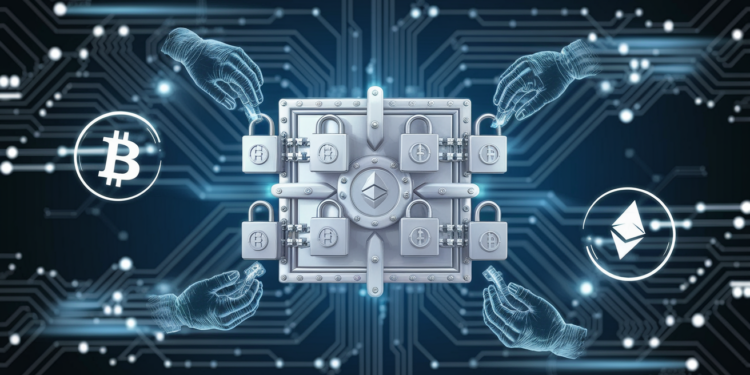Introduction
With hackers and cyber threats growing every year, protecting your cryptocurrency has never been more important. Large-scale hacks and stolen funds remind us that a simple wallet isn’t enough to stay safe. That’s where multisig wallets come in. They add an extra layer of security so your assets stay protected from theft and accidental loss.
This article explains what multisig wallets are, how they work, their advantages, and how to set one up. Whether you’re an investor, a business owner, or just curious, you’ll learn everything about this powerful security tool.
What Is a Multisig Wallet?
Definition
A multisignature wallet, or multisig wallet, is a type of digital wallet that needs more than one key to authorize a transaction. Unlike standard wallets, which rely on a single private key, multisig wallets use multiple keys. Only when enough keys are used together can a money transfer happen.
Core Concept
Think of a multisig wallet like a safe with multiple locks. To open it, you need a set number of keyholders to turn their keys. For example, a 2-of-3 multisig wallet requires two signatures out of three keys. This makes it much harder for someone to steal your funds unless they gain control of multiple keys.
Why Is It Important?
Multisig wallets are becoming popular in DeFi, enterprise security, and personal finance. They prevent single points of failure, reduce hacking risks, and give users full control over their assets.
How Does a Multisig Wallet Work?
Mechanism of Multisignature Authentication
In a multisig wallet, multiple private keys are involved. When you want to send crypto, a transaction needs signatures from the required number of keys. The process starts with creating a transaction, then each signer approves it by signing. Once all signatures match the rules, the transaction is finalized and sent.
Technical Foundations
Multisig wallets are built on blockchain protocols like Bitcoin’s BIP-11 and BIP-32 standards, and Ethereum’s Gnosis Safe. These protocols define how to set up multiple keys and verify signatures. Most modern wallets support multisig features and can work across popular blockchains.
Security Advantages
Having more than one key means fewer chances for hackers to steal everything. If one key is lost or stolen, the remaining keys protect your funds. For example, in a 2-of-3 setup, even if someone gets one key, they can’t move money without another. This setup drastically reduces the risk of theft and unauthorized access.
Types of Multisig Wallets
Shared Wallets
Shared wallets let multiple people control a single account. This is useful for families, partners, or teams. Everyone can agree on spending rules, making decisions together.
Threshold Schemes
Most multisig wallets use a threshold scheme, like M-of-N. This means you need M signatures from N total keys. For instance:
- 2-of-3: Any two keys approve transactions.
- 3-of-5: Three out of five signatures are needed.
This allows for flexible security arrangements depending on your needs.
Hardware vs. Software Multisig Wallets
Hardware Multisig Wallets
These use physical devices to store keys, like Ledger or Trezor. They are safer because keys stay offline, away from online threats. This option is ideal for long-term storage and high security.
Software Multisig Wallets
These are apps and programs on your computer or phone, like Electrum or Gnosis Safe. They are easier to set up and use but are more vulnerable to hacking if your device gets compromised. Best for daily transactions and simple control.
Custodial vs. Non-Custodial
Custodial Multisig
Some third parties manage the wallet for you. They hold keys and provide additional security but give up some control. Good for beginners or organizations that want a hassle-free setup.
Non-Custodial
You control all keys yourself—no third-party middleman. This gives you full control but requires careful key management. Ideal for users wanting maximum privacy and security.
Setting Up a Multisignature Wallet
Steps to Create a Multisig Wallet
- Choose a Platform: Select a wallet provider supporting multisig, like Gnosis Safe or Electrum.
- Generate Keys: Create or import private keys securely. Use hardware wallets for extra protection.
- Configure Signatures Needed: Decide on the M-of-N scheme, like 2-of-3.
- Finalize Setup: Save key backups safely in different locations. Verify setup works correctly.
Best Practices for Secure Setup
- Use hardware wallets for key storage.
- Avoid storing keys on internet-connected devices.
- Make multiple secure backups of private keys.
- Set strong, unique passwords for wallet access.
- Never share your private keys or seed phrases.
Managing and Using the Wallet
- Sign transactions in order, following the setup rules.
- Add or remove signers carefully, and always update securely.
- Regularly check wallet activity and conduct security audits.
- Keep wallet software updated to patch vulnerabilities.
Real-World Examples and Adoption
Case Study: Gnosis Safe in DeFi
Many DeFi projects use Gnosis Safe because it allows multiple signers to control pooled assets. It helps institutions manage treasury funds safely and transparently.
Notable Incidents and Protection
BitGo, a large crypto custodian, uses multisig wallets to protect billions of dollars in crypto assets. During theft attempts, multisig setups prevented unauthorized movement of funds.
Industry Trends
More companies and individuals are adopting multisig for added security, especially for large holdings and organizational wallets. This trend shows the importance of shared control in crypto security.
Benefits and Limitations of Multisig Wallets
Advantages
- Significantly boosts security against hacking.
- Shares control between multiple trusted parties.
- Offers flexible options, like 2-of-3 or 3-of-5 setups.
Challenges
- Setup can be complex, especially for beginners.
- Transactions may take longer with multiple approvals.
- Losing multiple keys can lock your funds forever if not backed up properly.
- Managing multiple signatures needs discipline.
Expert Insights and Recommendations
Many security experts agree that multisig wallets are among the safest ways to hold crypto. They recommend choosing solutions that fit your needs, be it personal or organizational. Always backup keys securely and test your setup before large transactions.
Avoid rushing into multisig setups without understanding the process. Proper management and secure environments are key to avoiding mistakes.
Conclusion
Multisig wallets offer a powerful way to make your crypto holdings safer. They reduce risks linked to hacking, loss, or theft. Different types allow customization for individuals, families, or large organizations.
If you want to protect your assets better, consider implementing a multisig wallet. It’s a smart move in today’s world full of digital threats. Take time to select the right setup, backup your keys, and manage your wallet carefully.
Start now—secure your cryptocurrencies with multisig technology and sleep a bit easier.

























